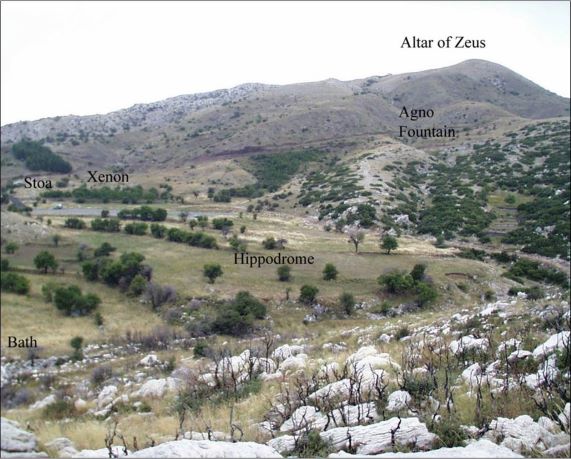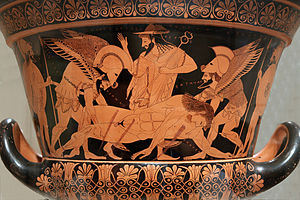With Halloween approaching you may well notice a few references to werewolves within the context of ancient Greece. But what are they referring to? Allow me to give a brief overview, I’ve also included a recent minisode I did on exactly this and included some general resources on it all at the bottom.
Lykaon.
The figure of King Lycaon is front and centre when it comes to werewolves in ancient Greece. It’s quite literally in his name as this translates roughly to ‘wolf’ in ancient Greek and an early surviving reference to him is a fragment of Hesiod. Being a fragment it doesn’t contain a great deal but just enough to give us a start. King Lycaon it seemed, took ordering off-menu to new heights. The fragment reads:
“After Zeus had seduced Kallisto (Callisto), [her father] Lykaon (Lycaon), pretending not to know of the matter, entertained Zeus, as Hesiod says, and set before him on the table the babe which he had cut up.”
Lycaon committed that most egregious of crimes, cannibalism. Not only that he did so when serving a god food and not just any god. Zeus was rarely one to play tricks upon but subverting the concept of xenia (being a good host) against the god who was associated with it was sheer folly.
Hesiod doesn’t mention the outcome and this varied in later myths but one was that he was turned into a wolf for his crimes. In others he’s killed outright.
Mount Lykaion – a home for werewolves?
Myths and stories about this event varied and one was reported by the Greek writer Pausanias (2nd century AD) who placed Lykaon as a founder for a ritual which resulted in a man changing into a wolf. This started when Lycaon sacrificed an infant to Zeus at the altar to him found on Mount Lycaon.
“It is said, for instance, that ever since the time of Lykaon a man has changed into a wolf at the sacrifice to Zeus Lykaios, but that the change is not for life; if, when he is a wolf, he abstains from human flesh, after nine years he becomes a man again, but if he tastes human flesh he remains a beast for ever” (Paus.8.2)
This mountain is found in Arcadia a central region in the southern Peloponnese which Lycaon was strongly associated with.

The mountain itself is formed of two peaks (Stefanos and Elias). The latter has both the infamous altar upon it and a sanctuary to Zeus lower down. This was no hidden location, the cult to Zeus hosted here was significant.

Often with myths there is something behind it all and it’s plausible that the Lycaon myth was used as a foundation for a wolf cult, possibly one which had human sacrifice as a feature. Though that said the excavation work on Mount Lykaion by by the Mt. Lykaion Excavation & Survey Project hasn’t found anything to support this. It’s plausible that there was a wolf cult present. Certainly by the time of Pausanias he thinks that something was still going on.
“On the highest point of the mountain [Lykaios] is a mound of earth, forming an altar of Zeus Lykaios, and from it most of the Peloponnesos can be seen. Before the altar on the east stand two pillars, on which there were of old gilded eagles. On this altar they sacrifice in secret to Zeus Lykaios. I was reluctant to pry into the details of the sacrifice; let them be as they are and were from the beginning.” (Paus. 8.38)
The last line by Pausanias fosters a sense of fear, was he scared to write any more on the current activities there?
Roman musings.
Pliny the Elder, a Roman writing in the 1st century AD, wrote down his version of events. He cited Euanthes who reported that the Arcadians would select a member from a family by lot. This individual was taken to a lake and hung their clothes on an oak tree. After crossing the lake he was changed into a wolf and if he could avoid humans for 9 years could return and change back. Pliny then concluded by mocking the Greeks for being so gullible as to believe this. Strong stuff from Pliny given his sometimes bizarre cures and conclusions but perhaps it’s that Roman snobbery against the Greeks in action.
Olympics?
A story which both Pausanias (6.8) and Pliny the Elder (34.22) both refer to is a boxer who competed at the Olympic games after going through the ritual in Arcadia and changing back to human form. It’s worth noting that neither believes this to have been the case, a boxing werewolf is too fanciful for either (but not for Hollwood – ever see Teen Wolf Too?).
Podcast(s).
In a recent minisode I cover much of the above, I also delved into the werewolf lore in ancient Greece and Rome in a couple of the #NightofTheLivyDead podcast episodes. You can find a list of these in the link below.
Previous Halloween themed episodes (including werewolves).
Sources.
Adam Douglas’ The Beast Within‘ is a superb book all about werewolves, it was very useful when gaining insight into the modern additions to werewolf lore. If you are interested in Mount Lykaion from an archaeological perspective then there are a few places you can find information they have a wordpress site which may not be updated but still has lots of information. You can also just search for them to find lots of their reports, again these were really useful for all of my werewolf podcasts.



